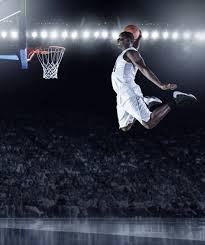We’ve been getting a lot of questions about what exercises to jump higher. Anyone who’s played basketball or volleyball knows the value of being able to go up and get after that ball.
But, the tough part is figuring out what and how to train to actually achieve the desired results. This often is a mystery, at least to many of us.
For anyone interested in building their own jump training routine these are the top exercises that will add inches to your vertical leap.
Note that these are just exercises and it is important to program them into a solid routine so that you’re not doing overlapping exercises which doesn’t maximize your training time. For complete training routines, we suggest looking at our top workouts to increase vertical here.
Just so you know that we aren’t pulling the exercises out of thin air, we’ll provide some scientific studies as back up proof that the exercises have been shown to improve jump height.
So let’s get started.
Best Exercises to Increase Vertical Jump
1. Squats
Squats are probably the most important lower body exercises around. Depending on how you use them you can target the front of the legs (quads) and also work them so that they focus on the hamstrings for explosiveness. HOW TO INCREASE VERTICAL JUMP
The 3 squats variations that help the jumper most are the:
- Back squat
- Box squats
- Front squat
Researchers from the University of Las Vegas observed that doing 4 warm up squats then 90% of your maximum half squat or quarter squat exercise improved vertical jump.
In a longer study where 22 high level athletes were divided into a group that were made to perform squat training twice a week for 2 months and another group that continued a regular routine. The squat training group not only showed bigger improvements in vertical jump after the 2 months but also better sprint performance.
Box squats are a great exercise that teaches athletes to explode upwards once they reach the box. This gives them the power they need when preparing to launch themselves when jumping.
2. Deadlifts
The other major lower body exercise that battles the squat for best overall mass building exercise is the barbell deadlift. Like the squat, it is important to learn proper form when doing the deadlift specially as you get to heavier loads.
While the squat focuses on building leg strength and power, the deadlift focuses on the posterior chain and is a pulling exercise. When it comes to jumping, the athlete benefits from the knee and hip extension power this exercise provides as well as strength to the back muscles, quads, hamstrings and glutes.
As far as scientific proof goes, researchers from Texas Tech University did a research where 54 subjects were split into a group that were given supervised deadlift training two times every week for 10 weeks and a control group.
At the end of the period the deadlift training groups showed an average of close to 1.5 inches increase in vertical jump height. More importantly their jump became more explosive thanks to the increase in rapid torque capacities of their knee and hip muscles.
3. Bulgarian Split Squats
Balance is key for the athlete and while the two exercises above focuses on bilateral (two leg) strength, it is important that you are able to take off even with your off leg.
The Bulgarian split squat is similar to the lunge except that the rear leg rests on an elevated surface, which is usually a bench.
This position forces you to balance yourself as well as isolate each leg so that it takes the brunt of the weight on its own. The Bulgarian split squat works the quads and glutes while giving the hip flexor of the rear leg a good stretch.
4. Trap Bar Deadlifts
For tall players or those with long legs, the squat often becomes a more difficult exercise. One other issue with athletes and squats is that they need to be taught proper form, which can sometimes go away once they start to fatigue later in the training session or the set.
Trap Bar Deadlifts are a cross between the deadlift and the squat where you have the pushing motion of the squat and the pulling motion of the deadlift. This exercise offers the athlete excellent range of motion and less to worry about form.
Trainers will often have the athlete stand on top of a 4 inch high box in order to increase the range of motion of this exercise. Doing so increases the engagement of the posterior chain which is very important in improving one’s jumping capability.
5. Power Cleans
Because jumping is an explosive dynamic action, it’s not enough to train strength. There has to be an explosive component to it. Power cleans, along with power snatches are excellent lifts that are designed for explosiveness.
These exercises help build maximum force which is one of the components needed to increase jumping ability. The motion also recruits the hip extensors which help improve both jumping and speed.
6. Toe Raises
Weighted toe raises are an exercise that helps build lower leg strength. The calves are one of the main muscles that help propel you up in the air and having strong calf muscles let you jump higher than others when you don’t have time to get a full knee bend before jumping, like in reaction situations or quick rebounds.
Weighted toe raises can be done while standing or seated. This exercise also helps develop ankle and Achilles strength and stability as well as improve range of motion.
7. Kettlebell Swings
The kettlebell swing is another explosive exercises that targets many of the muscles involved in jumping, including the hips, glutes, hamstrings and abs. In addition it also works the shoulders, the lats and your grip.
The motion used in this exercise is very similar to our jumping motion which makes it something the athlete can easily translate to. The motion goes through hip extension along with the shoulders in a forward and upward motion like when we jump.
A study done at the University of Chichester in the U.K. showed that kettlebell swing training improved maximum strength by 10% and explosive strength by 20%. This study put the participants through 12 minute kettlebell training twice a week for 6 weeks.
If you don’t have a kettlebell, holding a dumbbell vertically also works.
8. Reverse Hyperextensions
On the outside jumping looks like it is all about the legs pushing off the ground which makes exercises like the squat and split squat ideal.
However, what’s not often seen is the important role of the posterior chain in jumping.
Strong spinal erectors, glutes and hamstrings make a big contribution providing that extra lift. And reverse hyperextensions are a great way to hit all of these muscles with one single exercise.
9. Hip Flexor Stretch
This is one sneaky stretching technique that will surprise you with its results. Try it.
All you need to do is strength your hip flexors for half a minute, twice on each side. Then try jumping. If you compare it to your pre-stretch jump, you’ll see a difference. For some it goes to as much as 2 inches, without doing any other exercise.
Most of us have tight hip flexors because of all the sitting we do and also the direction where our hips bend naturally. Because of this, we aren’t able to get full hip extension when we jump which limits the vertical capability.
10. Plyometrics
We often see NBA players doing some plyometric training. Compared to weight training plyometrics make the muscles exert as much force as they can is very short bursts. Its goal is to improve speed and power.
Plyometrics is often called jump training because athletes are made to do jumps repeatedly when training.
Two great examples of effective plyometric jump exercises are depth jumps and vertical jumps
- Depth Jumps – depth jumps start with an athlete standing on a box then stepping off. Once they hit the ground they immediate bounce up, usually to another box that’s a different height from the one they stepped off from.
- Vertical Jumps – in this exercise, stand below the rim and in methodical, repeated motions jump up to reach the rim or as high as you can. This is done for 10 repetitions for 3 sets.
For more plyometric exercises for basketball and jumping higher see our article here.
Based a compilation of the different studies done on plyometric training, it has been shown that short term plyometric training routines have resulted in between 5% to 9% improvement in the vertical jump capability of athletes.
One program that uses advances plyometrics to boost jumping ability is Adam Folker’s Vert Shock System, you can also check out our full review here.
11. Core Work
If you look at jumping from a compartmentalized point of view, the main muscles that are working will be the legs. However, looking at the athlete as a whole, the core plays an important role in allowing us to jump higher. The motion of the upper body helps build momentum to lift us higher during jumps.
With a strong core, you’ll be able to transfer more of this power and momentum from the upper body to boost whatever power your legs are already providing.
This is one of the components many training programs often miss, core training, but is something covered in the better jump programs like the Jump Manual.
It is important to use weighted resistance since strength development and not endurance is what you’re trying to achieve.
A study done by the faculty at Guru Nanak Dev University in India showed that core strength training improved vertical jump performance of volleyball players. The exercises not only included ab workouts but also trunk stability.
All-Around Workout for Jumping
Just as important as knowing which exercises to train with, is making a solid workout program that combines them so you get the right results and not overtrain or end up imbalanced.
One excellent all-around jumping program that produces results is Jacob Hiller’s Jump Manual. For a full review of the workout program, see our write-up here.



